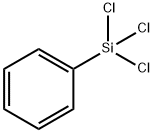3-Chloropropyltrichlorosilane
- CAS NO.:2550-06-3
- Empirical Formula: C3H6Cl4Si
- Molecular Weight: 211.98
- MDL number: MFCD00013694
- EINECS: 219-844-8
- SAFETY DATA SHEET (SDS)
- Update Date: 2024-12-18 14:07:02

What is 3-Chloropropyltrichlorosilane?
Chemical properties
Colorless clear liquid
Flammability and Explosibility
Non flammable
Properties of 3-Chloropropyltrichlorosilane
| Boiling point: | 181 °C |
| Density | 1.35 g/mL at 25 °C(lit.) |
| refractive index | 1.465 |
| Flash point: | 84°C |
| storage temp. | Inert atmosphere,Room Temperature |
| form | clear liquid |
| Specific Gravity | 1.35 |
| color | Colorless to Almost colorless |
| Hydrolytic Sensitivity | 8: reacts rapidly with moisture, water, protic solvents |
| Sensitive | Moisture Sensitive |
| BRN | 1737851 |
| CAS DataBase Reference | 2550-06-3(CAS DataBase Reference) |
| NIST Chemistry Reference | Silane, trichloro(3-chloropropyl)-(2550-06-3) |
| EPA Substance Registry System | Silane, trichloro(3-chloropropyl)- (2550-06-3) |
Safety information for 3-Chloropropyltrichlorosilane
| Signal word | Danger |
| Pictogram(s) |
 Corrosion Corrosives GHS05 |
| GHS Hazard Statements |
H227:Flammable liquids H290:Corrosive to Metals H314:Skin corrosion/irritation H318:Serious eye damage/eye irritation |
| Precautionary Statement Codes |
P210:Keep away from heat/sparks/open flames/hot surfaces. — No smoking. P234:Keep only in original container. P260:Do not breathe dust/fume/gas/mist/vapours/spray. P264:Wash hands thoroughly after handling. P264:Wash skin thouroughly after handling. P280:Wear protective gloves/protective clothing/eye protection/face protection. P310:Immediately call a POISON CENTER or doctor/physician. P390:Absorb spillage to prevent material damage. P303+P361+P353:IF ON SKIN (or hair): Remove/Take off Immediately all contaminated clothing. Rinse SKIN with water/shower. P305+P351+P338:IF IN EYES: Rinse cautiously with water for several minutes. Remove contact lenses, if present and easy to do. Continuerinsing. P370+P378:In case of fire: Use … for extinction. P405:Store locked up. P406:Store in corrosive resistant/… container with a resistant inner liner. P402+P404:Store in a dry place. Store in a closed container. P403+P235:Store in a well-ventilated place. Keep cool. P501:Dispose of contents/container to..… |
Computed Descriptors for 3-Chloropropyltrichlorosilane
New Products
Tert-butyl bis(2-chloroethyl)carbamate 4-Methylphenylacetic acid N-Boc-D-alaninol N-BOC-D/L-ALANINOL N-octanoyl benzotriazole 3-Morpholino-1-(4-nitrophenyl)-5,6-dihydropyridin- 2(1H)-one Furan-2,5-Dicarboxylic Acid DIETHYL AMINOMALONATE HYDROCHLORIDE 1,1’-CARBONYLDIIMIDAZOLE R-2-BENZYLOXY PROPIONIC ACID 1,1’-CARBONYLDI (1,2-4 TRIAZOLE) N-METHYL INDAZOLE-3-CARBOXYLIC ACID (2-Hydroxyphenyl)acetonitrile 4-Bromopyrazole 5-BROMO-2CYANO PYRIDINE 5,6-Dimethoxyindanone 5-broMo-2-chloro-N-cyclopentylpyriMidin-4-aMine 2-(Cyanocyclohexyl)acetic acid 4-methoxy-3,5-dinitropyridine 1-(4-(aminomethyl)benzyl)urea hydrochloride 2-aminopropyl benzoate hydrochloride diethyl 2-(2-((tertbutoxycarbonyl)amino) ethyl)malonate tert-butyl 4- (ureidomethyl)benzylcarbamate Ethyl-2-chloro((4-methoxyphenyl)hydrazono)acetateRelated products of tetrahydrofuran








You may like
-
 3-Chloropropyltrichlorosilane CAS 2550-06-3View Details
3-Chloropropyltrichlorosilane CAS 2550-06-3View Details
2550-06-3 -
 (3-Chloropropyl)trichlorosilane, ≥98% CAS 2550-06-3View Details
(3-Chloropropyl)trichlorosilane, ≥98% CAS 2550-06-3View Details
2550-06-3 -
 1975-50-4 98%View Details
1975-50-4 98%View Details
1975-50-4 -
 2-HYDROXY BENZYL ALCOHOL 98%View Details
2-HYDROXY BENZYL ALCOHOL 98%View Details
90-01-7 -
 2-Chloro-1,3-Bis(Dimethylamino)Trimethinium Hexafluorophosphate 221615-75-4 98%View Details
2-Chloro-1,3-Bis(Dimethylamino)Trimethinium Hexafluorophosphate 221615-75-4 98%View Details
221615-75-4 -
 14714-50-2 (2-Hydroxyphenyl)acetonitrile 98+View Details
14714-50-2 (2-Hydroxyphenyl)acetonitrile 98+View Details
14714-50-2 -
 118753-70-1 98+View Details
118753-70-1 98+View Details
118753-70-1 -
 733039-20-8 5-broMo-2-chloro-N-cyclopentylpyriMidin-4-aMine 98+View Details
733039-20-8 5-broMo-2-chloro-N-cyclopentylpyriMidin-4-aMine 98+View Details
733039-20-8
Statement: All products displayed on this website are only used for non medical purposes such as industrial applications or scientific research, and cannot be used for clinical diagnosis or treatment of humans or animals. They are not medicinal or edible.